#Castilleja coccinea
Explore tagged Tumblr posts
Video
n465_w1150 by Biodiversity Heritage Library Via Flickr: Nature's garden; an aid to knowledge of our wild flowers and their insect visitors Garden City, N. Y. :Doubleday, Page,1922. biodiversitylibrary.org/page/23671210
#Botany#Flowers#United States#University of California Libraries#bhl:page=23671210#dc:identifier=http://biodiversitylibrary.org/page/23671210#flickr#cardinal flower#Lobelia cardinalis#Castilleja coccinea#scarlet Indian paintbrush#scarlet painted-cup#broomrape
1 note
·
View note
Text

Castilleja coccinea (Scarlet Indian Paintbrush) by Sydenham Edwards.
Taken from 'The Botanical Register' (1815).
Museums Victoria.
archive.org
96 notes
·
View notes
Photo




Scarlet paintbrush (Castilleja coccinea) has edible flowers, or so The Arctic Guide: Wildlife of the Far North says of the entire genus. I would exercise caution.
#native Ontario plant species with edible parts#flowering plants#flowers#edible plants#native North American species#plants I want#scarlet paintbrush#scarlet painted cup#Castilleja coccinea#paintbrushes#Canadian vegetables
3 notes
·
View notes
Photo


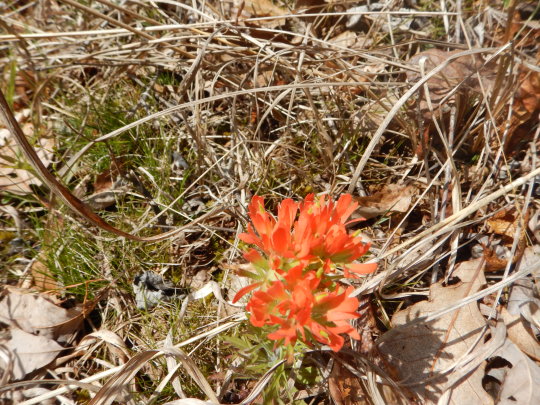
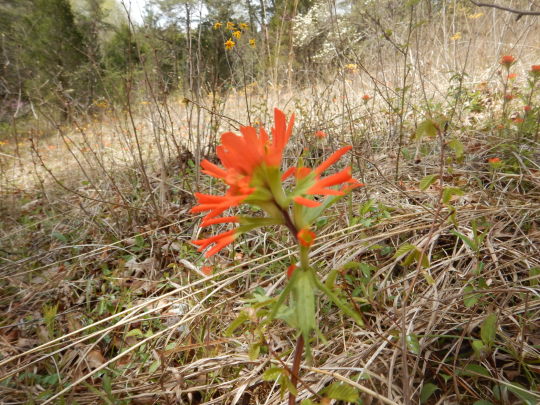
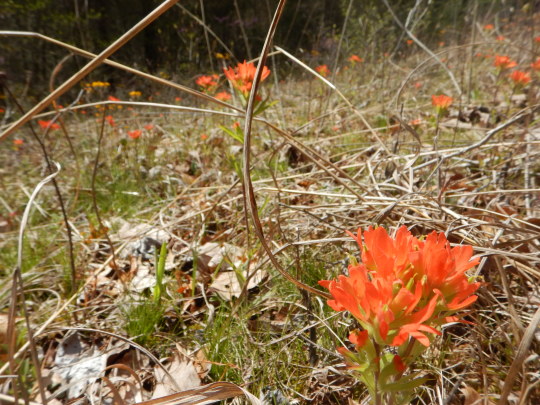

A nother early classic barren bloomer that I see along with prairie violets, birds foots, and baxter violet as well as the pacoons, yellow eye grass, blue eyed grass, and our strange white trout lilies( that prefer full sun and can take burns and propigate by mainly seed instead of asexual stolen forming bulbs), is this little Hemiparasitic plant. in Ohio, our hemiparasitic plants are pretty limited but in remnant communities, such as adams and scioto co barrens, they are vital in the ecosystem. In-situ, phyto chemical signalling is the main method that these seeds seek out a host, we see this by locating root traces of host plants; usually grasses, and tap into them with a special modified secondary organ called a haustorium.
Indian Paintbrush,
Castilleja coccinea
Low growing grasses and sedges are clear primary host: Hairy Grama, Blue Grama, Side Oats Grama, Buffalo Grass, Blond Sedge, Bristly Sedge Pennsylvania Sedge, Sweet Grass, and June Grass are the classic common featured species in this case.
Ex-situ, propigating these requires growing one of these grasses alone, in a container, and cutting a small divot in the root ball, sewing the seed directly into the root ball, and allowing it to establish.
In-situ ecology is much different; an established landscape has a dense rhyzosphere of featured grasses and sedge roots availible for germination. A hemiparasitic plant actually mitigates grasses spread and reduces their vigor so other barren/shortgrass prairie forbes can establish/ imbricate in the spaces in between. This means that if this plant is present, imbrication matrix patterns are usually very diverse.
20 notes
·
View notes
Photo

Indian Paintbrush
© 2019, James Blatter
#indian paintbrush#wild flowers#western wild flowers#castilleja coccinea#red flowers#flower photography#spring flowers#colorado wild flower
0 notes
Note
top 5 plants. it's the first thing that came to mind
its a good one!! i do have thoughts about it.
castilleja coccinea (the somewhat unfortunately named "indian paintbrush".... rip to this plant for that reason) which i love so much i have ink of
prickly pear cactus
tomatoes of all varieties. what would live be like without a tomato? we have 6 plants growing in our yard this summer, all different, all delicious. i could subsist on tomatoes alone and probably develop a protein deficiency and die happily.
lavender flowers, because i'm bisexual and they're beautiful
anything in the family cannabaceae. we must say thanks for those plants that are truly doing the most.
6 notes
·
View notes
Photo

Check out this glowing Scarlet Indian-Paintbrush (Castilleja coccinea) I found high on a bluff overlooking the mighty Mississippi River last May! This stunning species is hemiparasitic meaning it can live on its own but it does better when it parasitizes other plants for more nutrients. It’s primarily pollinated by Ruby-throated Hummingbirds (Archilochus colubris), the only hummingbird species common in Wisconsin.
12 notes
·
View notes
Text
Wild paintbrush flowers (castilleja coccinea).



0 notes
Link
22.2% Off on Real Datura Metel Double Purple Devils Trumpet 10 Seeds. TrueGether is one of the biggest and most trusted marketplaces with over 2M+ products for sale. Free delivery and returns on eligible orders. Buy Real Datura Metel Double Purple Devils Trumpet 10 Seeds at TrueGether.
0 notes
Photo
The Texas, Arkansas, Oklahoma spring blooming cows need to be a poster series or a series of paintings. Lupinus texensis, Castilleja coccinea, Gaillardia pulchella and cows <3 like if you agree.


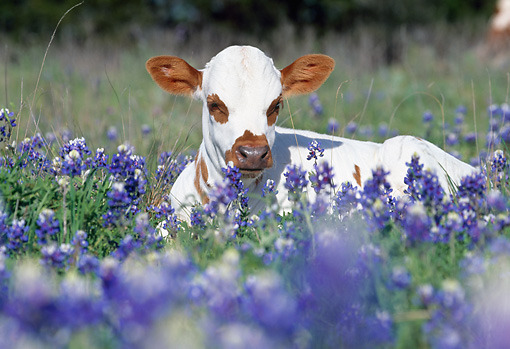



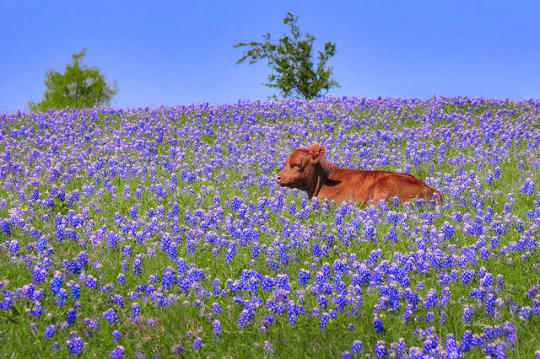



Cows in Flowers
267K notes
·
View notes
Photo

Indian Paintbrush (Castilleja coccinea)
0 notes
Photo

Scarlet Painted-cup, castilleja coccinea - high resolution image from old book.
0 notes
Photo





Common Indian Paint Brush,
Castilleja coccinea
At home in barrens and in dolomite/limestone prairies of Ohio this species is considered locally abundant, though connectivity between many of the populations means that until we get another strong semi-xeric interval, or until anthropogenic prairie expansion occurs again, we will see this pocketed populations get smaller and smaller until localized extirpation occurs.

I’ve tried to grow this ecotype before, I’ve tried the MN ecotype from prairie moon, and to no avail.
It’s finicky and requires a good amount of light to functionally germinate, however, while being hemiparasitic, it requires adiquite host roots to be present at or somewhat below the surface to where it may be able to gain access to the hosts root. Usually prairies with ample host distribution that have been around for 10+ years are the only bet. I still have 7 years left before I try again.
With that said, it’s still not clear, to me if that I necessarily have to do this,
It is not well understood if chemical signaling factors attract nearby host roots for Primary germination to function fully or if success is dependent on just light and seral plant hosts or prairie grass relationship. It is considered that other hosts are not primary hosts and only occur after establishment is already ensured.
Prairie Moon Nursery is attempting to create an experimental plug that they are openly selling with non guarantee warning. The host section used is “Common Rush seedlings”.
Typical conceptualized common grass planting hosts are that of: Koeleria macrantha, Carex blanda, Carex pensylvanica, Bouteloua gracilis. In tall grass and mid sized barrens we have Bouteloua curtipendula, Sporobolus heterolepis, Andropogon gerardii, and Schizachyrium scoparium.
While these are theorized species that are associated as primary grass and sedge layer that allow light after germination in fall. Other papers attempt to associate forbes for varying degrees of haustorial association, Many Penstomon spp., Rudibeckia spp. short grass Helianthus spp. Echinacea spp. and Gnaphalium obtusifolium have been considered for haustorial analysis; but, to little effect in lab sewn tests. Both Oenthera linifolia and Oenothera biennis, have been subjected to tests as well in-situ and ex-situ. The ex-situ single species test often fail and in many cases it is clear that best results occur in seral/ often disturbed sites with a mix of these species. Barren’s which are semi permanent xeric grassland openings are don’t appear to be studied to a great extent for host interactions as doing so can be seen as destructive.
A common species of paint brush in OKC shortgrass prairie is C. integra;
Which may provide more evidence of chemical signaling in common pot experiments where hosts are used as it seems to have much better results than the C. coccinea.
For me, I can’t wait till this mystery is solved, humming bird and skipper pollinated plants are extremely nice forbes and anything that can open up soil space and reduce vigor is a forbe treasure. This species is also a checkerspot supporter as a host species and often becomes a key element in checkerspot success where it is found. Theona Checkerspot is the only known checkerspot that can appear in east coast populations but primarily functions in the desert south west and central plains where other checkerspot species that utilize this plant are mainly western(feeding on western Castellija spp, only appearing in the central plains seldomly on this specific species.
read more?
https://scholarworks.uark.edu/cgi/viewcontent.cgi?article=2503&context=jaas
https://esajournals.onlinelibrary.wiley.com/doi/10.2307/1933763
http://npj.uwpress.org/content/18/3/252.refs
https://www.jstor.org/stable/2483296?seq=1
66 notes
·
View notes
Photo

Scarlet Indian Paintbrush (Castilleja coccinea): A parasitic flower usually found in moist meadows, prairies, and barrens from Maine to Minnesota. Pollinated by ruby-throated hummingbirds. #missourinative #prairie #flowers #hummingbird #nature #botany #parasite (at Shaw Nature Reserve)
0 notes
Photo

From the D.M. Brown Collection. Castilleja coccinea - Scrophularie 3955 - Indian Paint Brush. Port. DM
The D.M. Brown Collection consists of glass-plate lantern slides made by Brown in the 1930s as part of his dissertation research at Duke University on plant communities on Roan Mountain. This material was used by Dr. Brown during the 1930s and 1940s as a teaching aid for biology and botany classes he taught at ETSU, then East Tennessee State College. Images are primarily of local scenes and plants, including the Roan Mountain, N.C. - Tenn. area. The slides were apparently used in the department for some time following Dr. Brown’s death by other faculty before usage was discontinued. For more about the D.M. Brown Collection, visit: http://archives.etsu.edu/repositories/2/resources/723.
0 notes
Text
Scarlet Paintbrush
Roadways have been surprising me quite a bit as of late. Where I live, they are havens for aggressive invaders such as crown vetch (Securigera varia), sweet pea (Lathyrus odoratus), and a seemingly endless variety of turf grasses. However, this does not seem to be a pattern that repeats itself everywhere. More and more I have come to notice that roadsides in other locations harbor a wide variety of native plant life, some of which are downright surprising.
My most recent foray into Canada revealed some surprising roadside botany. While cruising down a highway, my friends and I began noticing bright red dots spread about the shoulders of the road. The red was so bright it was impossible to ignore. We had to find out the source. Within a few steps we soon realized where the color was coming from. It was none other than the scarlet paintbrush (Castilleja coccinea).
Needless to say, I was beyond excited. I have tried for years to grow this plant, which is endangered in the state of New York. All of my attempts have been met with failure so finally getting a chance to see this species was a momentous occasion. Like all others in this genus, C. coccinea is a hemiparasite. Using specialized roots it taps into the roots of neighboring plants and steals nutrients. Research has shown that C. coccinea doesn't seem to be too picky as to which plants it parasitizes, though it is likely that some plants are better hosts than others.
The plight of this species extends far beyond my home state. Native to much of eastern North America, this lovely species has been all but eradicated from the New England states. The most common reason for this is habitat destruction. We simply love to develop and farm the kinds of places that C. coccinea grows.
Another serious but less obvious threat to C. coccinea is succession. As is typical of our species, we tend to manage the land in a feast or famine sort of way. Its either total destruction or an adherence to an often false ideal centered around the word "pristine." A lack of disturbance is great for some species but spells disaster for others. Thus, as woody species, especially invasives such as multiflora rose (Rosa multiflora), encroach into open habitat, plants that cannot handle shading such as C. coccinea quickly disappear from the landscape. This is a species that requires some disturbance to survive. Land managers and stake holders would do good by paying attention to the habitat requirements of such species.
Further Reading: http://www.newfs.org/docs/pdf/Castillejacoccinea.pdf http://www.jstor.org/stable/2483296… http://plants.usda.gov/core/profile?symbol=caco17
8 notes
·
View notes